New computer models show that not all rainforests are the same. Some areas are dominated by a few species, while others harbor great biodiversity.
If we want to protect biodiversity, the first step is to understand it. We’re doing an increasingly good job at that, but there’s still much we’ve yet to learn. To make things even more challenging, we don’t even know how much we don’t know — how many species are still undiscovered, and how can we protect these undiscovered species?
Researchers have found an unexpected ally in computer models. Researchers employed modeling to provide more accurate estimates of the number of tree species in large areas and how they affect biodiversity. They then tested their models with real-life data and assessed its accuracy, finding that it predicts real-life scenarios satisfactorily. Dr. Sandro Azaele, from the School of Mathematics at the University of Leeds, said in a statement:
“Our new models can help predict the number of rare and unobserved species, a measure of fragile yet important biodiversity. We still do not know why the vast majority of Amazon tree species are so rare and only very few of them are very abundant.”
“However, it’s likely that hyper-rare species of trees, in places such as the Amazon Rainforest, are of great importance as the climate shifts, as some of them may become the common species of the future.”
These models show that in rainforests, about half of the trees belong to a tiny number of species. These are the common ones, called hyperdominants. In opposition, the other half of all trees comprise of many more species. So if we want to aim our conservation efforts at preserving as many species as possible, it’s important to focus on this latter half.
Protecting biodiversity makes entire ecosystems more resilient in the face of external pressure (such as rising temperatures and urbanization). Biodiversity helps provide support for life, vital provisions, regulating services and has a positive cultural impact, says Jayanth Banavar, provost and senior vice president at the University of Oregon and previously at the University of Maryland. It’s important to concentrate conservations efforts where they can make the biggest difference, and that’s usually the biodiverse areas.
“We are in the midst of an extinction crisis,” Banavar added, “we are losing species perhaps more rapidly than ever before. These species have evolved over many, many millennia. A species once lost is gone forever.”
Journal Reference: Tovo, S. Suweis, M. Formentin, M. Favretti, I. Volkov, Jayanth R. Banavar, S. Azaele & A. Maritan. ‘Upscaling species richness and abundances in tropical forests’, Science Advances. 18th October 2017










